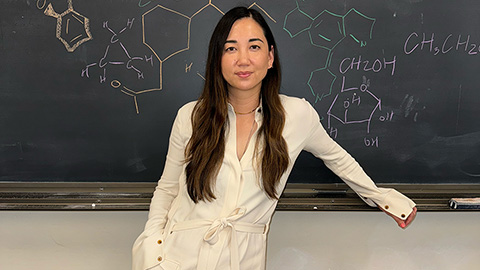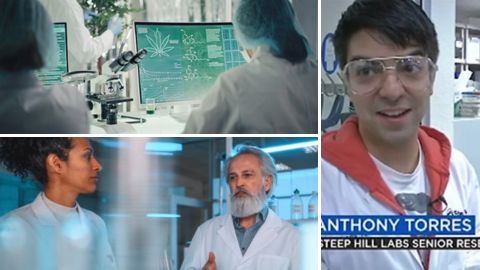'I still love figuring out how biology works'
In the field of lipid research, there is no higher honor than being chosen to give the Havel Lecture at the annual Deuel Conference on Lipids. The list of past lecturers reads like a Who’s Who of prominent researchers, including 17 members of the National Academy of Sciences, four of whom are also Nobel laureates.
Since the lectureship began in 2002, no scientist based in industry has received this prestigious honor — until now. The 2022 Havel Lecture will be given by Murielle Véniant–Ellison, a scientific executive director in Amgen’s Cardiometabolic Research group.

The selection of Véniant–Ellison highlights the respect she enjoys among peers for her long-term success in producing and publishing ground-breaking science. Her next publication will bring her personal tally to 100, which includes a high percentage of papers appearing in top-tier journals. Much of this research reflects work done at Amgen with her group and in collaboration with many different teams and scientific colleagues.
“I have been to the Deuel Conference for 25 years and have spoken there before, but not as the keynote,” said Véniant–Ellison. “I have to admit when I got the phone call telling me I had been chosen, I could not believe what I was hearing. My first thought was, ‘Am I up to the task?’ but I quickly said, ‘Of course I’ll accept, and thank you for thinking about me and giving me the opportunity.’”
The Deuel Conference focuses on the biology of lipid, or fat, metabolism and its impact on numerous interrelated diseases, including diabetes, obesity, NASH, heart failure, and coronary artery disease. The event is organized by the American Society for Biochemistry and Molecular Biology, and the 2022 conference will be held on March 1-4 in Monterey, California. The keynote lecture is named for Dr. Richard J. Havel, a pioneer in the field, and Véniant–Ellison’s topic will be “Targeting dual mechanisms for treating obesity.”
While Véniant–Ellison’s research across her career spans the breadth of cardiometabolic disease, she has a particular passion for obesity. Her interest is driven by a belief that patients with obesity need more than admonitions to eat less and exercise more.
“I never thought that obesity was just a lifestyle problem,” said Véniant–Ellison. “Caloric intake and energy expenditure are going to contribute to obesity, but that isn’t all there is to the disease. We now know that there are many genes that increase the risk for obesity, so if genetics are involved, it’s not just about lifestyle. It’s a real disease, and we've got to do something about it, because obesity is at the root of other problems like diabetes and heart disease, and it even increases the risk of dying from COVID-19.”
Forgoing the beach for summers in the lab
Véniant–Ellison traces her interest in science back to her childhood in France. “I grew up in a very small village, and my dad was the director of the village school,” she recalls. “Our apartment was above the classrooms, and the students were breeding guinea pigs to raise money for the school. Since I was always on site, I took care of the guinea pigs, and I became very attracted to thinking about animal life and their physiology. I didn’t know what a career in research meant at the time, but I knew it would have something to do with animals. I thought I would become a veterinarian, but that eventually turned into an interest in the life sciences and biology.”
In France, students choose their field of interest early, at around age 16. Véniant–Ellison chose to study biology in her lycée (high school), and then at the University of Dijon, where she received both her Bachelor of Science and a Ph.D. in pharmacology.
“In university, I started doing summer internships at Hoffmann La Roche,” she recalls. “Some people go to the beach for long summer holidays, but I was working in the lab. My friends would come back very tanned, and I was very pale, but I had done a lot of research.
“I decided to stick with research because I loved it so much. For me, the in vivo pharmacology where we get to see the effects of novel compounds in experimental animal models was the driving force for getting me up in the morning. I still love figuring out how biology works.”
Perseverance pays off
After a postdoctoral fellowship learning molecular biology at the Centre for Genome Research in Edinburgh and five years of research at the Gladstone Institute of Cardiovascular Disease in San Francisco, Véniant–Ellison accepted a job at Amgen in 2000.
One of her first assignments was to work with the clinical team for leptin, an Amgen obesity program that started out with high hopes and significant media coverage. But while molecules based on this hormone produced significant weight loss in mice, the results in human trials were disappointing, and the program was terminated.
In the years that followed, Véniant–Ellison’s primary focus was diabetes. As her responsibilities and the size of her research group expanded, her team also worked on investigational heart failure therapies. Throughout those years, she never lost hope in finding safe and effective obesity therapies — even during a lean stretch when the disease was not high on Amgen’s list of priorities.
“For a while, our obesity research program was in survival mode, but I still knew what we had here at Amgen was special,” Véniant–Ellison said. “Our group has always been very talented, and we really believed that we could make a difference. So, my philosophy was to keep the group focused on finding the molecules that would generate the most weight loss.”
The fruits of that perseverance can be seen in Amgen’s early-stage clinical pipeline, which includes an investigational therapy for obesity. AMG 133 is a bispecific antibody-peptide conjugate that targets gastric inhibitory polypeptide receptor (GIPR) and glucagon-like peptide 1 (GLP-1). A Phase 1 study is now underway to determine this molecule’s safety, tolerability, and pharmacological properties in human volunteers with obesity.
After a long road, cautious optimism
The broader field of research into obesity and related diseases has made significant strides in recent years. Medicines that mimic GLP-1 have already been approved to treat diabetes, and they have also been associated with weight reduction. One GLP-1 therapy was recently approved for that indication.
Véniant–Ellison said she believes that the key to continued progress may lie in engaging multiple targets with impacts on obesity, including GLP-1. “Obesity is a polygenic disease and multifactorial, so tapping on different pathways simultaneously may help to decrease weight to a greater extent than if we hit just one target at a time,” she observed. “In our animal studies, we found a synergistic effect by combining a GLP-1 peptide and anti-GIPR antibody. These bispecific molecules are doing something very unique at the molecular level.”
There’s a lot of work still to be done to assess the therapeutic potential of AMG 133—its benefit-to-risk ratio, and the types of patients most likely to achieve good outcomes. Genetic and protein markers may help to pinpoint those patients.
“It’s been such a long road to get to where we are now, so I don’t want to celebrate too soon,” Véniant–Ellison said. “But I do feel honored by the opportunity to give the Havel Lecture, and I'm excited and cautiously optimistic that an Amgen molecule could wind up helping patients. If we want to benefit society, we need to find new options for people with obesity. Effective treatments could mitigate the risks for a lot of other diseases as well.”
Enjoy reading ASBMB Today?
Become a member to receive the print edition four times a year and the digital edition monthly.
Learn moreGet the latest from ASBMB Today
Enter your email address, and we’ll send you a weekly email with recent articles, interviews and more.
Latest in Industry
Industry highlights or most popular articles

Black excellence in biotech: Shaping the future of an industry
This Black History Month, we highlight the impact of DEI initiatives, trailblazing scientists and industry leaders working to create a more inclusive and scientific community. Discover how you can be part of the movement.

Attend ASBMB’s career and education fair
Attending the ASBMB career and education fair is a great way to explore new opportunities, make valuable connections and gain insights into potential career paths.

Benefits of attending a large scientific conference
Researchers have a lot of choices when it comes to conferences and symposia. A large conference like the ASBMB Annual Meeting offers myriad opportunities, such as poster sessions, top research talks, social events, workshops, vendor booths and more.

Biotech startup worms its way into therapeutics
Andrea Choe's company, Holoclara, has created an anti-inflammatory drug based on a molecule from worms.

How military forensic scientists use DNA to solve mysteries
Learn how two analysts at the Armed Forces DNA Identification Laboratory use molecular biology and genetics to identify the remains of fallen troops.

Careers in industry: A year in review
Careers columnist Inayah Entzminger looks back at 12 months of interviews, advice and lists of resources.

